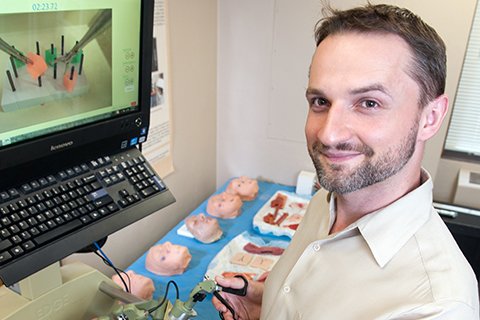Smarter Surgery: Timothy Kowalewski

An estimated 100,000 Americans die each year not from cancer or heart disease or stroke but from medical mistakes, an appalling statistic for a society that prides itself on having the most technically advanced medical care in the world. The figure makes medical error the 10th leading cause of death in the United States.
Of that number, almost a third, about 32,000, are the result of surgical errors. Additionally, surgical errors that result in death, coupled with those in which patients survive injuries incurred during surgery, account for an estimated 4.2 million extra days of hospital stay every year. It’s a figure that has staggering economic implications when one takes into account not only the average daily cost of hospitalization, but the productivity loss of employees taken off line by surgical mistakes.
“We focus on the technology used in surgery and on the person using the devices created by that technology.”
–Timothy kowalewski
This is where assistant professor of mechanical engineering Timothy Kowalewski enters the picture. As head of the Medical Robotics and Devices Lab, his mission “is to make surgeries safer.”
With that goal in mind, Kowalewski follows a two-fold path. “We focus on the technology used in surgery and on the person using the devices created by that technology,” he said.
First, Kowalewski’s team focuses on developing robotic smart tools. These are small surgical instruments that can supplement the qualitative “art” of surgical judgment with quantitative, real-time information about a range of critical factors. This enables new technologies like an alarm warning of tissue injury
before it occurs or tissue diagnostics at the tool tip during a procedure, like whether any unwanted, diseased tissue remains. Secondly, Kowalewski is working on the human side of the medical mistake equation—specifically, training and certifying practitioners.
“Surgery is taught by trial and error,” he observes. “One of our approaches is simulation, either through virtual reality or a physical simulator using realistic mock tissues that allow clinicians to learn and practice their techniques, making mistakes and learning from those mistakes before practicing on live patients.”
Kowalewski’s first application was in evaluating the skills of laparoscopic surgeons by capturing and analyzing their tool motion. His work was commercialized as the EDGE trainer by Simulab Corporation, based in Seattle, and is currently in use by the American Urological Association to create a skills certification exam. His current work employs da Vinci surgical robots, which are currently used in a wide range of minimally invasive operations. Equipping these instruments with sensorized “tissues,” Kowalewski and his research and medical partners created what he calls a “high-stakes certification exam whose parameters are created by top surgeons.”
“The test is called the Fundamentals of Robotics Skills for Surgery,” Kowalewski explains. “It was created by an international consortium of leading surgeons who use robotic instruments with a few of us engineers.”
“Skill evaluation is applicable to any kind of surgical robotics because all of them can store motion data during surgeries,” he said. “That, in principal, can be used to monitor and improve people’s skills.”
His specific research involves surgical robots with motion capture sensors. “This enables us to compare the videos and records of two different surgeons doing the same procedure and determine, quantitatively, which doctor is more adept at using robots during surgery. That data in turn will help to quantify what skills are needed and what works best in a particular surgical procedure.”
